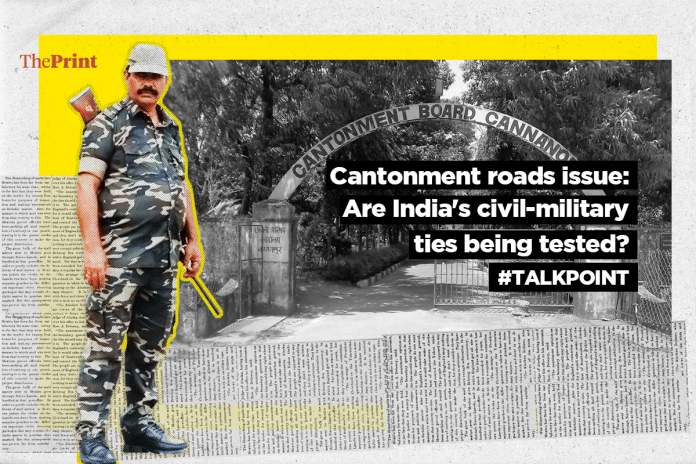Defence minister Nirmala Sitharaman last week defended the decision to open army cantonment roads to public. Out of the 119 roads that were closed without following procedure, 80 will now be open to public. The move comes in the wake of numerous letters written by MPs to review army’s decision on closing the roads.
Now, Indian Army chief General Bipin Rawat, in a bid to put all questions to rest, said Wednesday, “We can’t put civilians away. People will start becoming hostile”.
ThePrint asks: Cantonment roads issue: Are India’s civil-military ties being tested?
Blanket ruling doesn’t work, we need to strike a balance
 Lt. Gen. HS Panag (Retd)
Lt. Gen. HS Panag (Retd)
Former GOC-in-C, Northern & Central commands
Cantonments were established as townships, beginning with Danapur Cantonment in 1765. Within the cantonment, the military areas were exclusively on Type-A land. These townships also had bazaars, civilian zones and other municipal infrastructure. As the population grew, so did the demand for thoroughfare. This problem isn’t new, and existed even in the 1950s and 60s, albeit on a smaller scale.
As an army kid and as an army officer, I have lived in almost all major cantonments across India. This problem is omnipresent; it is only being hyped now.
The crucial thing is that a balance needs to be struck. One cannot have a blanket ruling either way – unrestricted access to civilians or a complete ban over security issues.
The situation in the cantonment is a peculiar one. The president of the cantonment board is the station commander, known as the local military authority. The cantonment board is an elected body. However, the real executive authority is with the CEO, who is appointed from the defence estates department, which is directly under the ministry of defence. He is not in the military chain of command. For efficient functioning, the CEO must be placed under the direct command of the local military authority as was the case a decade and a half ago.
To strike a balance, the control of the cantonment can be revised. Military stations can be created based on Type-A land. These areas should be exclusively managed by the armed forces, and passage can be restricted. Rest of the cantonment can be managed as is being done now. Another alternative is to create cocooned flyovers and underground roads for movement of civilians.
Even the army chief has spoken in favour of striking a balance. Security is important, but let’s not make it a bigger issue than it is.
It is not the civilian-military ties that are being tested. Rather, it is the needs of civilian population in and around the cantonment versus the requirements of security. When the security of the armed forces gets breached, it is not only an embarrassment for the forces but for the whole nation.
Free movement of civilians in cantonment areas may create a security hazard
 Lt. Gen. (Retd) S.L. Narasimhan
Lt. Gen. (Retd) S.L. Narasimhan
Member, National Security Advisory Board, and Distinguished Fellow, Centre for Air Power Studies
The decision of the defence ministry to open cantonment roads to public has resulted in a debate, and some analysts are saying that it is creating a rift between the military and the civilians.
A number of points need to be understood before we even venture into an analysis on the subject. The reason for keeping the army away from the cities is two-fold. Army’s training and mobilisation should not be revealed to the public as our adversaries may benefit from it. Second, in law and order situations, army is the last resort and some amount of deterrence needs to be maintained about its capabilities.
Cantonment areas have been increasingly merging with the cities due to uncontrolled growth. Poor implementation of the Cantonment Act and construction rules have aggravated the problem. There have been attacks on families residing in cantonments, which have stressed the need to maintain security in these areas.
Free movement of civilians in cantonment areas may create a security hazard. It may be argued that sentries may check the identity of commuters and allow entry. Such a measure is likely to result in altercations and impose a further administrative burden on the already stretched resources of the armed forces. Moreover, the greed for land and encroachments have been threats that presidents of the cantonment boards have been fighting against.
One hopes that due diligence was carried out before the order was passed by the defence ministry. The order passed by it has a window for reviewing the same after a month. One is confident that both the defence ministry and the armed forces headquarters have the wisdom to arrive at the correct decision after the review.
Civil-military ties determined more by how armed forces are governed
 Manvendra Singh
Manvendra Singh
Former member, standing committee on defence, and editor- in-chief of Defence & Security Alert
Raksha mantri’s decision was influenced by constant petitions from various political representatives across the country. And it is true that the decision did cause serious heartburn among the military fraternity. But to claim that the issue is testing civil-military ties is stretching the point beyond reasonable bounds.
The issue is serious, without a doubt. And to understand what it means to the military and their families, it is important to first get an idea what life means in a cantonment.
The three arms of the military structure live and train to fight the next battle. Because they have volunteered to don the uniform, some of their fundamental rights are forfeited, which include free speech. So, as a token of appreciation for making that commitment of supreme sacrifice, the armed forces are bestowed with certain privileges, which are their rights.
One of these privileges is that their families live in a safe, secure and clean environment. The last cannot be overstated, for the cleanliness of a cantonment is the hallmark of military discipline and culture. The same is certainly not possible when litter and all kinds of stains are a certainty once military roads are open to public use.
Civil-military ties, on the other hand, are determined more by how the armed forces are governed, in matters of pay and allowances, promotions and postings, and equipment modernisation. Matters are not hunky dory in that direction either, but that has nothing to do with cantonment roads being opened to public. Those issues require greater social and political awareness.
Government has opened a Pandora’s box with this decision
 Brig. Dinkar Adeeb (Retd.)
Brig. Dinkar Adeeb (Retd.)
Served with the Indian Army’s Judge Advocate General’s Department
One random day, we woke up and heard this order on army roads being opened to public. It is very similar to the demonetisation move – one hardly knew what was the genesis of the decision.
The order has come completely out of the blue. The problem is not new, and has been raised and debated earlier.
What all provisions were analysed? What all was taken into consideration? Who moved the files? What exactly happened? How was the decision processed? These are the important questions to ask.
It seems like the government has opened a Pandora’s box. The system was working fine. The Cantonment Act is available in the public domain. It was passed by Parliament, and is not an executive order. There are procedures available for closure of roads in cantonments.
One assumes that when a minister takes a decision, due diligence is done. Some transparency in the process would go a long way.
This isn’t about right or wrong, or having a popular opinion. This is a nuanced issue that must not be debated like a controversy.
Civilians and the army aren’t two separate warring groups. They’re not at odds because of this, neither will they be.
In next 5-10 years, cantonments won’t be able to serve their purpose within city limits
 Gagandeep Singh Ghai
Gagandeep Singh Ghai
Architect, The Design factory, and STR Consultants
When cantonments were designed, they were made beyond city limits. But as the city grew and the population increased, so did civilians around cantonments. As a result, the area around cantonments became congested.
Defence is a sensitive factor; it has to be given priority. Army roads are maintained by the armed forces, and when the situation calls for it they have to be cordoned off.
However, in a democracy, we need to keep facilities available for public use. Civilians must have access to these roads once the scenario has been assessed.
At present, both purposes are in direct conflict. Even two blood brothers living under the same roof often agitate against crowding in the house. A similar situation has developed between civilians and the army over cantonment roads.
It is likely that in the next five to 10 years, cantonments will not be able to serve their purpose within the ever-expanding city limits. The maintenance and security requirements in a cantonment are way higher than in a civilian area. We need to think bigger if we have to address growing space constraints.
The alternative approach would be that all the paraphernalia be handed over to civilian authorities. They could build hospitals, secretariats, and use the land as they deem fit. These authorities can purchase the land and infrastructure directly from the army. The funds for these can easily be generated from the property handed over to civilians.
The army can then establish its cantonments outside the city limits (with strict-zoning plans of no civilian construction in 1-km limit as applicable in case of ammunition depots).
Compiled by Deeksha Bhardwaj, journalist at ThePrint.







But why did the army chief Bipin Rawat agree to the proposal -the govt is saying the army chief agreed. The question is did the army chief sell the army short? The reporter should have interviewed the army chief why he agreed.
Mr Ghai,
What to do nxt once the growing town again knock the New Military Li action boundary…
So Military will move out again..till the time it goes out of boundary of the country…
Better is no construction in 5 KM zone of Military Location